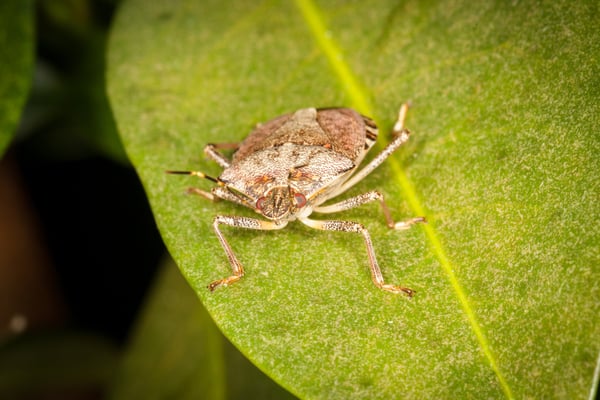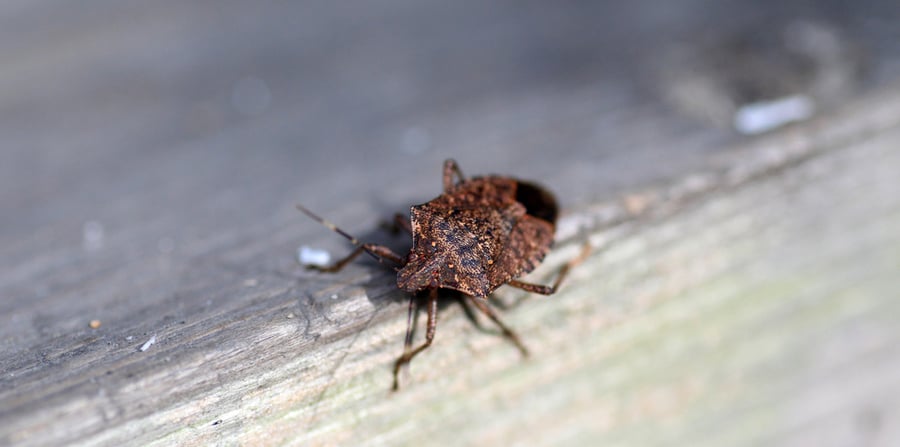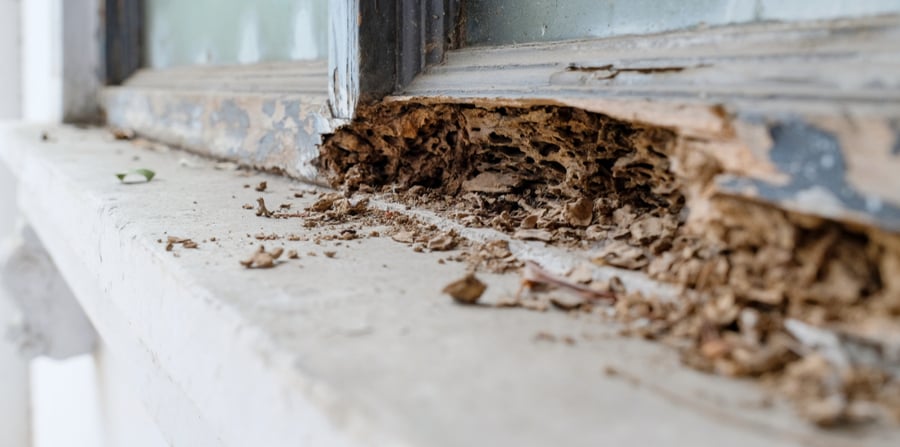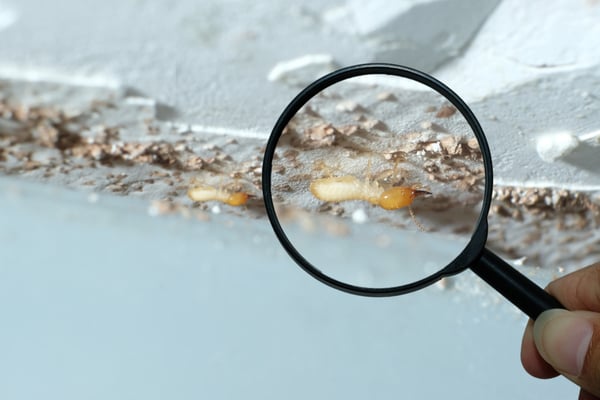Stink bugs start congregating around sunny, heat-reflective surfaces in early fall. They tend to find these surfaces close to the fruit trees they use for food source all summer. Eventually, stink bugs find their way into buildings by crawling through small access points near the warm surfaces they seek out.
Stink bugs bother farmers all year, but most of us will probably only notice them around fall. As temperatures start to cool down, you might notice stink bugs gathering in clusters around your home. In fact, you might notice a lot of the stinky bugs gathering around you. Maybe a weird number of them. Always gathered around your house, specifically. Why you? Here’s why stink bugs prefer some homes over others, and how you can keep them off of yours:
Why do I have stink bugs?
Stink bugs are an invasive species native to Southeast Asia’s tropical climates, so they’re very sensitive to dropping temperatures. The moment temperatures start dropping, they start looking for places where they can keep warm. The stink bugs around you are probably sunning themselves on heat-reflective surfaces or gathering around other naturally warm places. If you have a lot of stink bugs around you, then your home is probably particularly good at keeping them warm.
The longer the sun shines on your home, the more stink bugs it tends to attract. If sunshine hits your home directly for long periods, the heat that sunlight generates will attract stink bugs. You’ll probably find them gathering around heat-reflective surfaces like windows, light paint, concrete, or whitewashed siding. Stink bugs will try to find heat sources as close to their food sources as possible. If you have fruit trees, berry bushes, or vegetable gardens, you’ll find more stink bugs around your home than usual.
How do stink bugs get inside?
If stink bugs want to survive winter, they have to figure out a way to stay warm until spring. Unfortunately, they may attempt to use your home to do that. Stink bugs tend to enter homes starting in mid to late fall. Upon entering, they find secluded nooks and crannies in walls or other hidden areas and go dormant until spring. The same heat that attracts stink bugs to your home eventually leads them inside.
Believe it or not, stink bugs usually aren’t looking for a way in when they arrive at your home. Instead, they’re really just looking for a place to lounge in the sun. When stink bugs find a good lounging spot, they secrete a pheromone that attracts more stink bugs. As more stink bugs arrive, they often literally push each other into the nooks and crannies around your home. After stumbling into these nooks and crannies, stink bugs follow the heat they give off all the way inside.
Are the stink bugs in my home dangerous?
No. Stink bugs don’t bite, sting, or transmit diseases. They can’t really inflict any significant structural damage, either. When stink bugs enter homes, they will seek out secluded areas in warm and humid areas. When they find a good place, they’ll simply go dormant. In spring, stink bugs will attempt to leave on their own. They’re considered a “nuisance pest” indoors because even though they’re annoying, stink bugs are not considered a “serious” problem.
Stink bugs start congregating around sunny, heat-reflective surfaces in early fall. They tend to find these surfaces close to the fruit trees they use for food source all summer. Eventually, stink bugs find their way into buildings by crawling through small access points near the warm surfaces they seek out. Stink bugs bother farmers all year, but most of us will probably only notice them around fall. As temperatures start to cool down, you might notice stink bugs gathering in clusters around your home. In fact, you might notice a lot of the stinky bugs gathering around you. Maybe a weird number of them. Always gathered around your house, specifically. Why you? Here’s why stink bugs prefer some homes over others, and how you can keep them off of yours:
Why do I have stink bugs?
Stink bugs are an invasive species native to Southeast Asia’s tropical climates, so they’re very sensitive to dropping temperatures. The moment temperatures start dropping, they start looking for places where they can keep warm. The stink bugs around you are probably sunning themselves on heat-reflective surfaces or gathering around other naturally warm places. If you have a lot of stink bugs around you, then your home is probably particularly good at keeping them warm.The longer the sun shines on your home, the more stink bugs it tends to attract. If sunshine hits your home directly for long periods, the heat that sunlight generates will attract stink bugs. You’ll probably find them gathering around heat-reflective surfaces like windows, light paint, concrete, or whitewashed siding. Stink bugs will try to find heat sources as close to their food sources as possible. If you have fruit trees, berry bushes, or vegetable gardens, you’ll find more stink bugs around your home than usual.
How do stink bugs get inside?
If stink bugs want to survive winter, they have to figure out a way to stay warm until spring. Unfortunately, they may attempt to use your home to do that. Stink bugs tend to enter homes starting in mid to late fall. Upon entering, they find secluded nooks and crannies in walls or other hidden areas and go dormant until spring. The same heat that attracts stink bugs to your home eventually leads them inside. Believe it or not, stink bugs usually aren’t looking for a way in when they arrive at your home. Instead, they’re really just looking for a place to lounge in the sun.When stink bugs find a good lounging spot, they secrete a pheromone that attracts more stink bugs. As more stink bugs arrive, they often literally push each other into the nooks and crannies around your home. After stumbling into these nooks and crannies, stink bugs follow the heat they give off all the way inside.

Are the stink bugs in my home dangerous?
No. Stink bugs don’t bite, sting, or transmit diseases. They can’t really inflict any significant structural damage, either. When stink bugs enter homes, they will seek out secluded areas in warm and humid areas. When they find a good place, they’ll simply go dormant. In spring, stink bugs will attempt to leave on their own. They’re considered a “nuisance pest” indoors because even though they’re annoying, stink bugs are not considered a “serious” problem.That being said, stink bugs can be a “serious” nuisance. After all, they… stink. When threatened or crushed, stink bugs secrete a liquid from a specialized defensive pore. This liquid smells like coriander, cilantro, or rotting vegetables. It is (infamously) unpleasant, and it can also stain carpeting and other surfaces. The more stink bugs gather, the worse the smell and potential staining. If too many stink bugs get inside your home, they become disruptive simply because you’ll run into them everywhere. Stink bugs are never dangerous, but you won’t want them in your home.
How can I keep stink bugs out from my home?
It’s difficult to keep stink bugs from wanting to sun themselves on your home. You don’t want to block out sunlight or remove your fruit trees, after all! Even if stink bugs do congregate on the surfaces of your home, however, you can keep them from getting inside. First, find the areas where the pests gather. Look for them around windows, light paint, siding, concrete, and other reflective surfaces. Pay special attention to door and window frames!When you find the stink bugs, don’t crush them. Instead, try vacuuming them up or spraying them away with a hose. When they’re gone, wash the surface where they congregated with soapy water or ammonia. This will wash away the pheromone the bugs secrete and replace it with an odor they find repellent. Next, look for any cracks or gaps near these congregation sites and seal them with caulk. Make sure you seal up access points on the outside and the inside!
Yes, stink bugs really do favor some houses over others. No, it really isn’t fair. On the (literal) bright side, though, if stink bugs like your home, it’s probably because of how sunny and warm it is! That… probably doesn’t feel like much of a consolation when you’re dealing with the stinky pests, though.
If you have a stink bug problem, get in touch with Plunkett’s Pest Control any time. Our experts can remove stink bugs, figure out how they got inside, and make sure they can’t get inside again. The sooner we get started, the better we can keep stink bugs out for the winter--so get in touch now!









